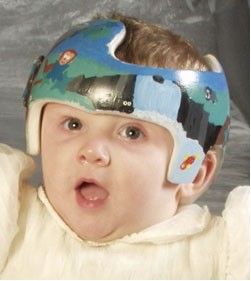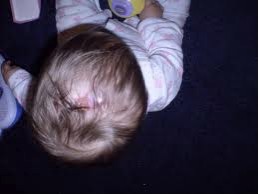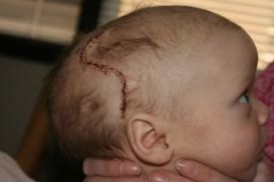Children's Health
Skull Deformities (Plagiocephaly) and Developmental Delays in Children: The Benefits of Cranial Care
"Why cranial adjusting for infants and children?" you may ask. That is an excellent question, and I will attempt to give you an overview of the subject.
First of all, it is important to realize that the most dramatic increase in brain volume occurs in the last 3 months of gestation and the first 2 years of life. Head growth in the fetus and infant is largely determined by brain growth. Please take note that the brain reaches 90% of adult size by 1 year of age; it is 95% of its ultimate adult size by 6 years of age, and growth is complete by age 7. Therefore, birth to 2 years of age gives us the greatest opportunity to intervene to maximize outcomes. In fact, the brain volume a child achieves by the age of 1 year helps determine later intelligence. Growth in brain volume after infancy may not compensate for poorer earlier growth. (Gale, CR, et al, Avon Longitudinal Study of Parents and Children Team)
By age 7, many of these distortion patterns can only be addressed with great difficulty and perseverance. I have worked on older children, with good results – after all, as a parent, you find out about cranial work when you are first introduced to it. However, if you know a child with any of the following issues, the sooner they can get treated the quicker the problems resolve, and the better the outcomes.
Common pediatric conditions that are accessible to cranial care, since they are often caused by cranial distortions, include:
- colic,
- poor breastfeeding or poor latching on,
- disrupted sleeping patterns,
- torticollis ("wry" or "stiff" neck),
- ear infections,
- vomiting and regurgitation,
- constipation,
- eye problems (turning in or out),
- hearing or balance problems,
- delayed speech,
- teeth grinding (after the age of 6),
- recurrent upper respiratory infections,
- ADD/ADHD,
- developmental delay.
Why would an infant have cranial distortions? There are several reasons, among them: intrauterine position, presentation and difficulty of vaginal delivery, iatrogenic causes at the time of delivery (oxytocin and vacuum extractions), too fast a delivery and Caesarian section.
The last two items may seem counter-intuitive. First of all, why too fast a delivery? And, what is too fast anyway? For the bab's skull and organs to get the proper stimulation, hard labor should last at least 3 hours, and the pushing phase should be at least 20 minutes to up to an hour. Less than that and the vagus nerve (which supplies all of the internal organs) is not properly stimulated. Also, the head doesn't have a chance to mold and unmold slowly. Too fast is simply not good for the baby's function.
But why C-section? It seems as though that would be ideal, with no trauma to the infant. Well, that isn't exactly true, because oftentimes, the child is pulled out by whatever part presents in the incision, and the traction can be considerable. Also, because the skull doesn't receive the proper molding the craniosacral respiratory rhythm does not start up properly. That means the neurons are not getting adequately bathed in cerebral spinal fluid, and all of the various cranial bones are not synchronized in their movements with one another.
 Another very common cause of cranial distortion is the American Pediatrics Association's "Back to Sleep" campaign. Laying an infant on its back constantly can distort the soft bones of the skull, leading to major distortions in the occiput. And, if the child is born with a strain pattern to begin with, the head will tend to roll on to the flat spot, exacerbating the distortion. Unfortunately, the current medical treatment is a helmet. However, the helmet does nothing to correct the underlying strain and restriction in the dura and skull. In fact, it often just ends up creating more restrictions.
Another very common cause of cranial distortion is the American Pediatrics Association's "Back to Sleep" campaign. Laying an infant on its back constantly can distort the soft bones of the skull, leading to major distortions in the occiput. And, if the child is born with a strain pattern to begin with, the head will tend to roll on to the flat spot, exacerbating the distortion. Unfortunately, the current medical treatment is a helmet. However, the helmet does nothing to correct the underlying strain and restriction in the dura and skull. In fact, it often just ends up creating more restrictions.
The medical term for a deformed skull is plagiocephaly, of which there are two major kinds: Type 1 from cranial synostosis, for which the medical treatment is surgery; and Type 2 which is deformational and is by far the most common. Type 2 is often called non-synostotic deformational plagiocephaly (NSDP) and is the condition for which helmets are prescribed.
There is a great deal of data in the medical literature to suggest that children with NSDP are at great risk for developmental delays and visual field defects. In addition, the restriction in brain development may affect I.Q. {Pediatrics 2000; 105:e26, Kordestini, Patel, et al., Plastic Recon. Surg. (Jan 2006), Siatkowski, Fortney, et al. JAAPOS (Jun 2005)}
I want you to know that there is another option, besides standard medical care. Gentle cranial manipulation is very successful for NSDP (Type 2) and can even offer hope for Type 1, if undertaken soon enough and with enough rigor.
 While Type 2 is much easier to treat, I feel that I must point out that the surgery for these Type 1 patients is not the best option. The problem with Type 1 is that the treatment schedule is intense and the parents must maintain it daily at home. However, there are some parents who might not opt for this choice if they understood the downsides of the surgery. For one thing, the surgical scar is very disfiguring.
While Type 2 is much easier to treat, I feel that I must point out that the surgery for these Type 1 patients is not the best option. The problem with Type 1 is that the treatment schedule is intense and the parents must maintain it daily at home. However, there are some parents who might not opt for this choice if they understood the downsides of the surgery. For one thing, the surgical scar is very disfiguring.
 It might not be so bad if the youngster has hair to cover it, but as the person ages (particularly in men) hair loss will make it quite visible. A more disturbing aftermath is that, as the child continues to grow and develop, the skull will grow unevenly (since the sutures no longer expand), leading to "Elephant Man" like protrusions on part of the skull. The outcome is quite variable and cannot be predicted in advance.
It might not be so bad if the youngster has hair to cover it, but as the person ages (particularly in men) hair loss will make it quite visible. A more disturbing aftermath is that, as the child continues to grow and develop, the skull will grow unevenly (since the sutures no longer expand), leading to "Elephant Man" like protrusions on part of the skull. The outcome is quite variable and cannot be predicted in advance.
So, when should a child's cranium be examined by a doctor qualified in cranial manipulation? The best answer is as soon after birth as possible — usually at about 2 weeks of age. Then, if everything seems fine, a follow-up should be scheduled for 3 months of age, since a number of these distortion patterns take that long to show up.
Another question that you may have is: How long do more conservative treatments take? For simple cases of birth trauma, 2 to 5 visits at one-week intervals should suffice, with that check up at 3 months. However, when you are dealing with intra-uterine constraints, the treatment program can last 6 months to a year. By the way, that's the same amount of time that the children wear the helmets — which aren't really correcting the underlying function in the cranial vault, or helping brain growth or intelligence.
Finally, I just want to say that we all want the best for every child we meet, and cranial adjusting is all about helping every child develop his or her full potential. Left uncorrected, the individual will never manifest what might be lurking inside, because the cranial restrictions inhibit his or her full development. There's always time for more extreme measures, but I personally believe that there is no treatment more full of promise than doing cranial work with infants and young children.
Does this apply to you? If so, see our information on Consultations.
[TOP]
© 2011 Richards Family Health Center. This site or any part may not be reproduced without the written consent of Richards Family Health Center. N Rowan Richards, DC, DABCI, FIACA at 242 South Glendora CA 91741. 626 963 1678. email:richardsfhc@richardsfamilyhealth.com. This site is Not intended to dispense health advice or serve as a substitute for actual patient contact with a qualified healthcare provider. Our sole purpose is one of education. It is our expectation that our site can educate our visitors about the efficacy of some healthcare treatments that exist as an alternative to conventional medical wisdom.
PRIVACY POLICY: Richards Family Health Center takes your privacy very seriously. Be assured that we do not sell or rent your contact information to anyone.


